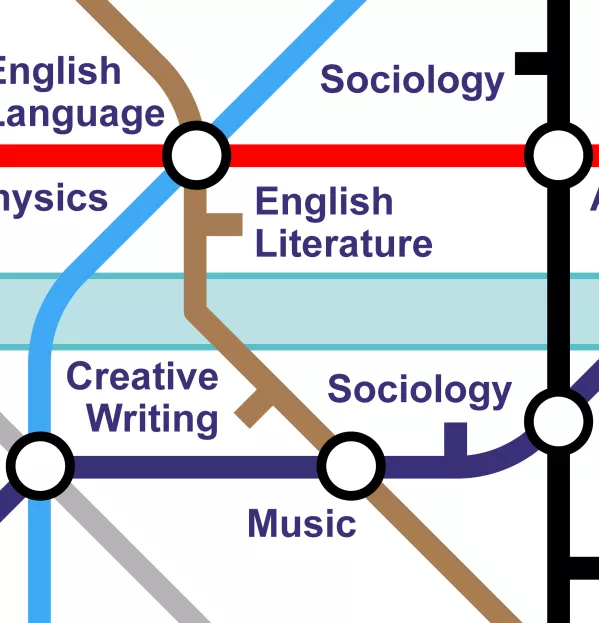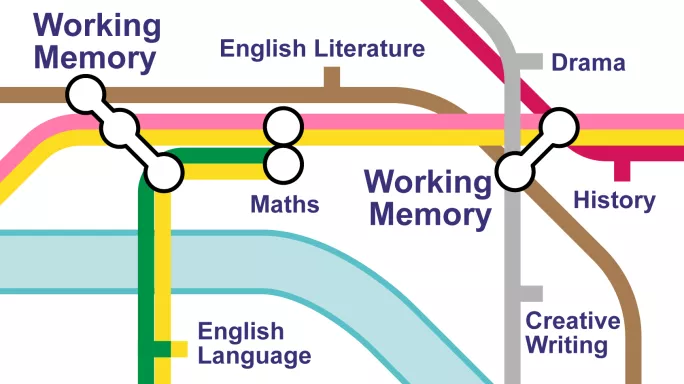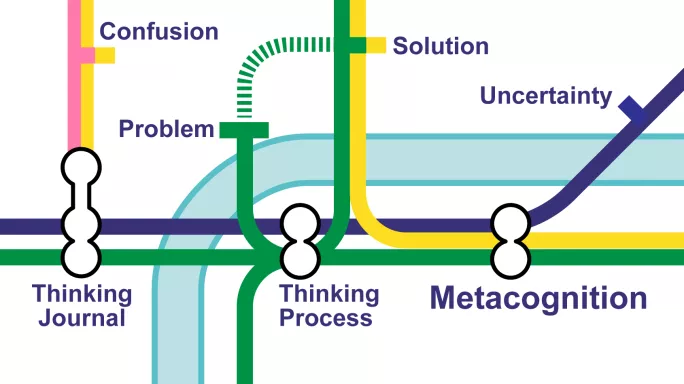- Home
- Teaching & Learning
- General
- Is knowledge transfer education’s holy grail?
Is knowledge transfer education’s holy grail?

Imagine that you are at the edge of a forest and you want to get to the other side.
The forest is thick with trees, brambles and dense undergrowth. The first time you try to go through, it will take a lot of effort to push and slash through all the vegetation. But the next time you go through it is easier.
As you go through the forest often, you start to make a path, which makes it even easier and quicker to get through. From then on, it makes most sense to use this path, so you do.
At some point, you might go off to explore a different forest and you will have to go through the same process again there, beating out the path bit by bit. When you return to the original forest, you might find the path is a bit overgrown. It will take more effort to get through than when the path was completely clear, but a lot less than the first time - how much easier it is depends on how long it’s been left and how overgrown it has become.
This analogy is one way to think about how our brain changes as we learn. Certain connections between neurons are strengthened as you use them more. Think of all that time spent practising times tables as slashing down brambles. The more you practise, the easier it gets. Then the summer holidays come along and you find things a bit overgrown when you return to school (the neuron connections have become weaker or have even been pruned away). But as you pick up your machete, you find there actually is a path still under there somewhere.
Teachers are involved every day in manipulating the human brain. In fact, teachers are really the only people whose specific job it is to change the connections between neurons in other people’s brains - and many are now increasingly looking to evidence from educational neuroscience to help them do this.
One concept that is often seen as something of a holy grail for learning is “transfer”.
Neuroscience in education: what is transfer?
Transfer describes the ability to take learning from one situation and apply it in another. Given how the brain works, this is a difficult task, since without explicit instruction otherwise, knowledge lies in silos.
Nonetheless, the idea that some superpower might exist at the top of the learning pyramid that, if we train it, cascades down to many other levels has proved a stubborn one - with article after article suggesting that, for example, playing chess can help to raise your general intelligence, despite years of evidence that such a magic bullet does not exist.
The persistence of this idea is partly because some degree of transfer does happen automatically. If we know how to drive a car and we then play Super Mario Kart, we can transfer a great deal of knowledge - of how to steer, accelerate, brake, avoid obstacles - from one environment to the other (probably not a great idea to test transfer the other way). If we know the word for “love” in French is amour and then we go to Italy and hear the word amore, we see the connection. We spot patterns that we recognise from one situation in another.
When knowledge is reactivated via working memory, associated knowledge can also become active in long-term memory that connects to, or is similar to, the new information. As well as offering up connection points and overlaps, past knowledge is essentially recycled into the current learning and can help give it meaning.
But harnessing this automatic ability is another thing altogether.

Can we teach transfer?
Over the years, there have been many targets of hope for transfer “miracles”. Recently, working memory has been set up as the miracle emissary. It has been wrongly conceived as a general-purpose bucket that any kind of content can be moved “into” or “out of”. This created the expectation that the right training could enlarge the bucket, or would put the bucket on wheels to pick things up and drop them off anywhere.
If such a general-purpose processing mechanism existed, this expectation might have been realised. The reason it hasn’t is because the whole concept is wrong: working memory is not a general-purpose, fillable-emptiable bucket. Rather, it is the ability to reactivate, maintain and manipulate the contents of long-term memory systems.
If a task that involves working memory improves, what has improved is the brain’s ability to use its frontal cortex to reactivate, maintain activation of and manipulate a particular set of content in those meaning systems - visual systems, spatial systems, auditory systems. This doesn’t generally improve the ability of the frontal cortex to do the reactivating, maintaining, manipulating job, and it doesn’t improve the ability to carry out these operations in different meaning systems or with alternative content. It just improves the ability to carry out that particular task.
‘We approach transfer not as some mystical superpower but as a skill that can be trained’
However, working memory certainly plays a very important role in thinking and learning, and there is strong evidence of association between working memory performance and achievements in arithmetic, reading and overall educational attainment.
Working memory ability also improves steadily throughout the school years, which suggests it might be more amenable to intervention than if it were already fully developed when children start school. So there has, and continues to be, much interest, both in schools and from commercial companies, in training it; many of the “brain training” games that are available are targeted at improving working memory. But to reiterate: although working memory can be improved with training, training effects are typically specific, short-term and do not generalise (Melby-Lervåg and Hulme, 2013). This is fine if there is interest in improving a specific skill but disappointing if the hope is to train one thing and see cascading improvements elsewhere.
It is not all gloom and doom, though. Building on our understanding of the brain does give us an idea for an approach that might be more successful: the idea that we need to train students in transfer. This means we recognise that transfer will not happen by some magical secret process but may happen with the help of explicit instruction. We approach transfer not as some mystical superpower but as a skill that can be trained.
The skills involve teaching students to approach a new situation with the idea of searching through their previous knowledge, skills and strategies to see what might be relevant. It is teaching students to think about their thinking and learn about how they learn. It’s more meta than Zuckerberg. It’s called metacognition.
Metacognition and teaching for transfer
Each of our brains is constructed on the basis of our unique individual experiences in the world. Any single experience only produces a partial representation: a set of neurons activated by that particular context. This representation contains the relevant knowledge as well as all the neural, physical and social context in which the knowledge was formed.
This knowledge is spread throughout the brain, not in a storage box but widely distributed. If and when it is reactivated, it is as an approximation of the original, not a perfect facsimile. It is likely to be a better approximation if it is elicited in a similar context rather than a totally dissimilar one.
- Research: How neuroscience can help struggling pupils
- Tes Explains: What is metacognition?
- Metacognition: 7 strategies to use in any class
In fact, it is often hard to activate knowledge in a different context. Partial representations do not easily transfer. To transfer knowledge to a new context - key to meaningful learning - means the brain being given lots of chances through repeated exposure to enough partially overlapping representations. Revisiting knowledge in different contexts and repeated practice accessing it are key. The final piece in the puzzle is the teacher explicitly highlighting the commonalities - the overlaps, the bit we are trying to learn (Hobbolog, 2016). It’s about equipping the brain to recognise the cues in the new situation that will prompt the retrieval of relevant knowledge.
Teaching for transfer can mean many things. It might mean teaching how past learning can help current learning. An example might be an explicit task such as asking students to recall what they learned about the causes of the First World War to see if those can help explain the causes of the Second World War. It might mean teaching how current learning can help future learning.
For example, teaching students how to read a graph (highlighting the key sensory and motor features: the lines of the different axes, the different types of graphs, such as scatterplots, bar charts, line graphs) means that when they encounter graphs in other subjects, they will be able to see the similarities. More complex teaching for transfer might involve using metaphors and analogies to draw out links between separate pieces of knowledge.
‘Revisiting knowledge in different contexts and repeated practice accessing it are key’
Good teachers already do many of these sorts of things, making links and connections to add meaning to new learning situations. Teachers are the most crucial agents of transfer.
The idea of metacognition takes these a step further, formalising the process of thinking about thinking and learning. Metacognition involves monitoring the thought processes involved when you are learning, identifying when you have hit a problem and knowing how to change tack. An example might be in a task that involves thinking of all the animals you know beginning with the letter T. You might start off by just letting ideas come in, then when those run out, switch to a deliberate strategy, such as creating categories to focus the search: animals that live in the sea, pets, animals you find in zoos and so on.
Metacognition is a key skill for learning at all ages because it involves the construction of a set of personalised steps, adapted to fit our own thinking processes, that we can follow. The first steps of implementing metacognitive approaches are to focus students not on the endpoint but on the process of getting there. We are less interested in right or wrong answers and more interested in the mechanics.
You can think of it as a kind of helping hand, which assists us in carving a path through the forest, in a way that automatic transfer alone would not.
To work well, metacognitive approaches need to encourage introspection - looking at oneself and one’s thinking almost as if from the outside. It also relies on teacher feedback.
Stimulating metacognition enhances our own knowledge about our thinking and with practice, improves the monitoring of the thinking process itself. It can apply to all the many aspects of the thinking and learning process - social, emotional and physical factors as well as cognitive ones.

How to develop metacognitive skills
Keeping a “thinking journal” is one easy place to start with metacognitive behaviours. For students, simply noting times when they have become aware of confusion or uncertainty about what action to take can be helpful, particularly if it is followed up with writing about what happened next - how did they deal with the situation? Over time, this process log can become a useful guide to strategies and approaches to help students take more responsibility for their own learning. Debriefing by teachers can help students to become aware of strategies that might be applied in other situations, and those that might be less helpful.
We would emphasise that this process is most effective when it is most inclusive of what constitutes “thinking processes”. We are not talking solely about “cold thinking” (information processing) but the feelings and emotional responses to different stages of the work.
Metacognition is as much about identifying “at this point, I felt really unmotivated because the task ahead seemed so great” as “at this point, I asked myself whether drawing a picture to help me understand the problem might help”: the emotional and the cognitive hand in hand.
There are many ways to start developing metacognition. Some common ones are:
- Being able to say what you know, what you don’t know and what you would like to know.
- Deliberate planning: this can include practical tasks such as working out how much time something will take and developing rehearsed, reflective cognitive approaches, such as asking, “What strategy have I used before that might be helpful here?”
- Taking time and knowing what to do with it. Using strategies to break down problems into recognisable steps.
- Developing vocabulary around thinking. Modelling is important here so that students can understand what is meant by “thinking processes”.
Metacognitive skills can be developed at a very young age; three-year-olds show metacognitive abilities when they are solving problems (Whitebread et al, 2007). Developing these skills at a young age has benefits not only for the student but also for the teacher, since making the thinking process explicit makes it easier to spot where problems are occurring.
The nature of thinking, and metacognitive thinking, changes as children get older. Here are some further strategies that can work at different stages, as pupils progress through school:
Key stage 1
For children younger than about 6, simple tools might help them to understand and develop their own emotional self-regulation.
For instance, a traffic light system - where green (go) means you are feeling happy, calm and ready to learn; amber (pause) means you are feeling bored or frustrated; and red (stop) means you are feeling angry or upset - can be a first step in helping children to identify and act on how they are feeling. Children can match their feeling with a signal, which points to remedial actions they could try. For example, children identifying themselves in the red zone might identify the action “take 10 slow breaths” or “ask to take a break”.
Key stage 2
Children in later primary years can be taught more sophisticated strategies linked to particular content or situations. At this age, they are likely to differ greatly in how well-developed their executive control skills are (these allow them to deploy strategies in the moment). Some are likely to need more scaffolding with this.
Repeated reflective questions can be a useful touchpoint at the start of and throughout a new piece of learning. This might involve questions about the task (“is this task too challenging?”, “what is hard about it?”, “are there easier parts?”, “where is the best place to start?”), about themselves (“am I motivated to stick with this when it’s tricky?”, “what can I do to keep myself focused?”) and about strategies (“what can I try if I get stuck?”, “are my notes helping me understand or do I need something else?”, “do I need to ask the teacher for help?”).
Secondary school and beyond
By adolescence, language knowledge and executive function skills are well developed and metacognition can focus on specific items on the syllabus, with study skills classes to target transfer, application of knowledge and skills to new situations, problem solving and self-evaluation.
At this age, group work and metacognition can be very productive companions. Learning about how others approach their thinking can be helpful in expanding individual repertoires. Practising the art of making thinking explicit by doing it out loud in group work helps to create a culture in which thinking about thinking becomes the norm. It is also likely to be a useful approach for the staffroom.
Mission cognition
There are many questions that educational neuroscience has barely begun to wrestle with, such as: what exactly are the best ways to improve cognition?
In recent years, action video games, mindfulness meditation, aerobic exercise, bilingualism and chess have all been considered as potential approaches that might meet the aspiration of achieving widely transferable benefits.
Although the goal of far transfer remains something of a mirage, many of these approaches have shown more local benefits: improved attention control of visual processing through playing first-person shooter action video games; improved health and better executive function through certain kinds of aerobic exercise; improved emotional regulation through mindfulness training.
On the other hand, some approaches that seemed theoretically promising (playing chess, musical training, increased quantity of sleep) have not withstood real-world scientific scrutiny of their benefits - beyond, of course, the obvious joys of playing chess or music or, indeed, a good night’s sleep.
So, if our goal is to improve transfer in a general sense - and make the road through the forest easier to tread in the process - metacognition seems a good place to start.
Cathy Rogers is a science writer and researcher and a former television producer on science programmes. Michael SC Thomas is director of the Centre for Educational Neuroscience at Birkbeck, University of London
This is an edited extract of Educational Neuroscience: The Basics, by Cathy Rogers and Michael SC Thomas, published by Routledge in 2022
You need a Tes subscription to read this article
Subscribe now to read this article and get other subscriber-only content:
- Unlimited access to all Tes magazine content
- Exclusive subscriber-only stories
- Award-winning email newsletters
Already a subscriber? Log in
You need a subscription to read this article
Subscribe now to read this article and get other subscriber-only content, including:
- Unlimited access to all Tes magazine content
- Exclusive subscriber-only stories
- Award-winning email newsletters
topics in this article



